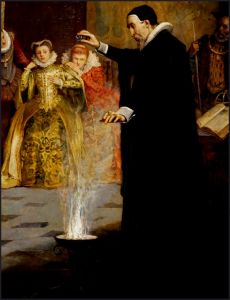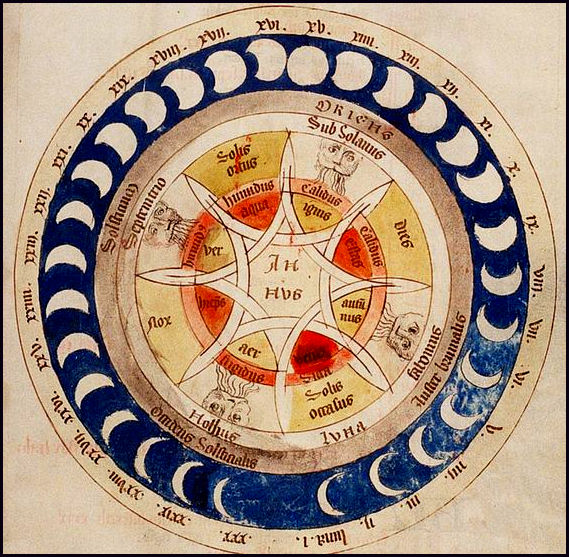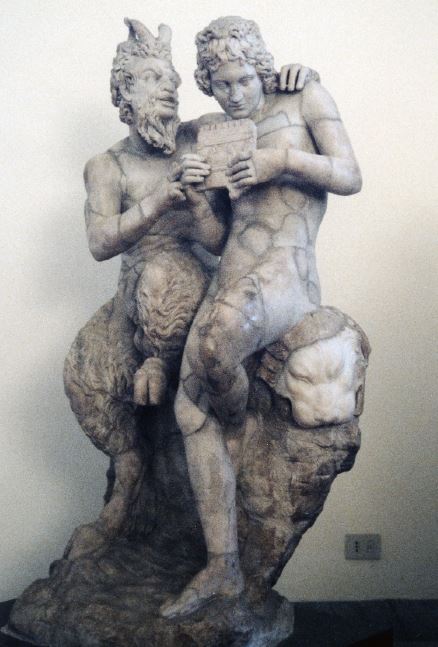
Vishnu and Lakshmi on_Shesha Naga, Lakshmi stimulates the dream of creation.
This is a continuance of Astrological Mysticism in The Surya Siddhanta. Since that article was written several months ago, I have managed to obtain other texts on Indian Astrology which have served to explain or fill in apparent gaps. I have also been fortunate to meet highly accomplished Indian astrologers who were amenable to discussing how Indian techniques might be used in concert with Hellenistic astrology, I came away with two techniques that seem to be particularly useful and, to my way of thinking,, add much-needed dimensions.
My time here is not to go into any of these texts in depth but I will make them available to the reader who desires a broader compass. I will caution ahead of time that less is often more, particularly when the goal is practical in nature. Of course, particularly when discussing Indian Astrology, practise and spiritual discernment is as important as in its Hellenistic, Persian, Egyptian, Druidic or Babylonian counterparts.
This can only serve as the simplest of introductions to two techniques used in Indian astrology. To tell the entire story would require the retelling and analysis borne of millennia. I, therefore, present this with due humility in the hope that it might spark interest in other practitioners of Hellenistic astrology.
Jyotish translates as “science of light,” and refers to the profound and mathematically sophisticated form of astrology originating in the earliest texts. Jyotish is as revered in the sub-continent as authentic astrology is largely undervalued and even reviled in the modern West. The essential tenets of Jyotish, including the nomenclature of the science of light, will not seem alien to a practitioner of |Tradional Western astrology. In fact, there is, therefore, an unbroken chain of this science of light going back to very ancient times.
In a previous article, we discussed The Surya Siddhanta of an unknown date. It was readily available in the 11th and 12th Century AD. The translation most commonly seen is that of Ebeneezer Burgess, published in 1860.. However, there is solid evidence that it was much older, perhaps existing in oral form long before that, It is also widely understood that changes had been made over the years
With uncertain provenance we must take what we have on its own terms., assisted by reference to other Indian astronomical works., It should be borne in mind that the same is true for all ancient forms of astrology. The relationship between Spirit and Matter is common to all, in a developed form it is germane to the sciences, although differing nomenclature may be adopted. I have elected to employ the term Indian Astrology because it is practised from the Himalayas to Kanyakumari with surprisingly little variance, all things considered.

“The yantra is a mystical or astronomical diagram used as an amulet or charm. Beneficial in getting rid of insufficiency, competitors, resentment and bad effects of planets” – Neeta Singhal
The word Vedic can be misleading as can the nomenclature of Hindu astrology because it is used not only by Hindus, but also Sikhs, Jains, and Muslims. There are also many practitioners of Jyotish globally, but there is never any doubt of its origin in its present form. There is also an undeniable connection with the yogas and the gods are of Indian origin both Vedic and later.
For reasons which are not entirely clear, the intermingling of astrological cultures over millennia didn’t result in complete transference of some of the most useful elements of Indian astrology. Perhaps the chief of these is the Nakshatras system and an adequate understanding of the Nodes. Classical, Islamic and European sources tend to be vague on the subject of the Nodes and some don’t mention them at all. My friend and colleague Clelia Romano have done a splendid job of surveying the opinions of the Nodes and has provided 40 chart readings of people with mental illness to demonstrate how the Nodes work. A pdf from her site is available here.
Nakshatras are divisions of the zodiacal wheel by 27 which are further subdivided to arrive at the mystically significant of 108 The divisions of four are called padas and they are assigned planetary qualities. The Nakshatras are anchored to the stars so one might use a Tropical zodiac with Sidereal Nakshatras. This is not common practise in India because the Sidereal zodiac is usually (but not entirely) for all purposes. they are Lunar Mansions and Rahu and Ketu are also Lunar based.

This simple chart shows the positions of Nakshatras, showing planetary lords and ruling deity.
For the Western Astrologer, the use of a Sidereal Zodiac s problematic. Think for a moment that you have always known you were a fiery personality with a Leo Sun, an Aries Ascendant and Moon in Sagittarius. The Sidereal reading would have you be a Cancer Sun, a Pisces Ascendant and a Scorpio Moon. The elemental change alone is enormous, even before considering the signs. themselves. We are tropically oriented. Our system is based on the Solstices and Equinoxes and the Sidereal is based on the stars. But as fortune would have it, we can use the Tropical for the Signs and the Nakshatras at the same time.
The question arises, of course, as to why a Western Astrologer would eschew the various systems of 28 Lunar Mansion in favour of the Indian model. The truth is that Lunar Mansions are not used that much in the West, largely, I should think because they offer us very little information and even that much can be vague. Moreover, each version gives us different information. The great exception is the use of astrological magic and fine-tuning a particular element of a chart or indeed as a tool in chart rectification.
Because of the nature of the nakshatra,. we can discern a great deal about the nature of the soul’s first point of contact with the material world, as was explained to me by a highly credible Indian astrologer. Now, of course, such things are relevant in a plurality of systems. But we don’t actually suggest what was the nature of a previous incarnation or indeed one yet to come., There were attempts in the 70s and 80s riding high on the misguided New Age era. From the School of Theosophy came swaggering confidence that one could simply make up association using only the nodes.
It needs to be said that the idea of reincarnation or the transmigration of souls is solidly established in the European tradition from Plato to the Druids, who may have actually preceded the Indian sages on this matter. Brahmins have referred to the Druids as their European cousins or brothers. Indeed, early Christianity had proponents of reincarnation until they were silenced by orthodoxy. So the metaphysical of a mystical framework already exists, yet Traditional Astrology appears to avoid the question. I’m quite sure that the reason for this is the influence and threats of the Abrahamic religions.
So, a Hellenistic or Persian astrologer could employ Nakshatras, with a Tropical zodiac and in fact, this is done by Indian Astrologers both within and outside the sub-continent. Let me provide one example of how this can be done. This is a chart calculated in a Hellenistic programme, showing the 27 Nakshatras, the Padas and the traditional Chaldean Decans. It so happens that the Whole Sign system is the most often used on the Indian sub-continent. The Hellenistic astrologer is not required to make any essential changes beyond using the Nakshatra and taking the Nodes as seriously as Vettius Valens.

We find the Lagna (Ascendant) is in the 27th degree of Libra – the Nakshatra is Vishaka, which occupies 20-00 Libra To 3-20′ Scorpio. Jupiter is the Lord and the symbol is an Archway and both Indra and Agni preside. Indra is one of the oldest gods from the Rigveda and Agni is both a god and Fire. The short description or general characteristics: include energy, strength and potential power, bright in appearance, well spoken and adept at making money. The Pada is Gemini and Mercury is very happy here. Jupiter brings a driving idealism in this place. The character is described as being versed in scriptures. So we would derive a charming and effective person, an idealist desirous of change towards justice, but one whose health is likely to be fragile.
Sometimes the Moon Nakshatra is studied, along with the Sun or any other point. However, the Lagna seems particularly important and immeasurably more so when considered in relation to the Nodes. The western astrologer might use this useful astrological tool. However, we haven’t got the full benefit until we have studied Rahu and Ketu through the eyes of Indian Astrology:.

The creation of Rahu and Ketu is told in the creation myth itself. The story is one of immortality stolen by a dissembling demon. This is the most pertinent part of the story for our purposes:
Devas (demigods) appealed to Vishnu, who then took the form of Mohini and as a beautiful and enchanting damsel, Mohini distracted the asuras, took the amrita, and distributed it among the Devas, who drank it. Asura Rahu-Ketu, disguised himself as a deva and drank some nectar. Due to their luminous nature, the sun god Surya and the moon god Chandra noticed the switching of sides. They informed Mohini. But before the nectar could pass his throat, Mohini cut off his head with her divine discus, the Sudarshana Chakra. But as the nectar had gone down his throat he did not die. From that day, his head was called Rahu and body was called Ketu. Later Rahu and Ketu became planets. The story ends with the rejuvenated Devas defeating the asuras.
Komilla Sutton writes “Rahu Ketu is the name given to the Nodes of the Moon. Rahu is the North Node and Ketu is the South Node. They are points on the ecliptic where the Moon is in alignment with the Sun and the Earth. They indicate the precise point of harmony with the three most important influences in our life- the Sun, the Earth and the Moon. This relationship plays an important part in the unfolding of individual consciousness.”
Dark forces gaining divine attributes through deception is an archetypal tale of the Fall. The attempt to kill the Asura, only made him more malefic. It is not true that the N|odes are always malefic, but they often are and should be studied closely. Whether or not they are demonic isn’t up for debate. They have advisedly named shadow planets. They are secretive and not always easy to detect.
According to Sutton: “Rahu behaves like Saturn. It deals with drugs, poisons, over-ambition, power play, hidden knowledge… Rahu’s element is air. It deals with all aspects of air-related activities air travel, Air accidents, Aviation, Pilots etc. Other significations of Rahu include students of Astrology, metaphysical knowledge, witchcraft, skin diseases, smallpox, deception, politics, political manoeuvre, inventions, scientists, execution, diseases, disenchantment etc.”

Rahu
Rahu is the head and for our immediate consideration, the mouth. Rahu is forever hungry and analysing. He can eat but lacks the body required for digestion. This brings with it an obsessive nature. Of course there will always be other considerations required to get the full picture, but imagine in Rahu were in the fifth house. The perennial hunger could result in excessive, even uncontrollable gambling or result perhaps in what is now called sex addiction. Desires are out of control.
In the tenth house, Rahu might manifest as an unquenchable desire for prominence. In the second house, Rahu can never have enough possessions. This need has almost nothing to do with wealth. We can see this in compulsive collectors who are never satiated and always looking for the next piece. The drive will never be satisfied because Rahu cannot digest. He is perennially hungry and the hunger is insatiable..In Indian astrology, the 2nd house includes speech as its province. This could a mellifluous voice with an occasionally sharp tongue.
Rahu in the first house belongs to people who can’t seem to get enough of themselves. They may well appear selfish to others. But of course, Ketu will be in their seventh house. This brings a crisis in relationship pursuits. Obviously, the other elements of the chart will affect how this is expressed.
If we refer back to our sample chart, where we found the Nakashatra Vishaka, on the Ascendant, we now add Rahu to the ninth house, this could subvert the good qualities by exaggerating. The fictitious person might tend towards a degree of fanaticism in religion and the domains of Jupiter.
Ketu is the headless body. Kee5tu can usually indicate something about what has past, including what preceded your physical being in this life. What Ketu wants most of all is-Moksha -liberation. Because no ‘thing’ can give that, Ketu rejects what is available where he is. So, Rahu is unsatiable appetite and Ketu is on the opposing side of the spectrum. They are desire and aversion personified if you will. IF this results in rejecting negative elements, then all is well and good. But if helpful elements are discarded, this could be quite devastating.
Importantly, the “Nakshatra’s Ketu rules are Ashwini (Aries), Magha (Leo) and Mula (Sagittarius), the fire triplicity. These are the beginning stages in the cycles of life. Mars, Sun and Jupiter the rulers of Aries, Leo and Sagittarius are friends with each other. Together they represent strength, the soul and wisdom, Ketu has the capacity to give in these areas. A proper blending of these three planets in our natal charts direct us towards seeking Moksha- the final liberation from the cycle of life and death.” See Sutton, Komilla

Ketu Dev Tail of Demon Snake
Most intriguing is that Mula is the most difficult and painful of the Nakshatra because the work is to cut through all illusion. In relation to the fire triplicity, we can say that warrior, sage and sol are dramatically energized by Ketu in the quest for Moksha.
The examples I’ve given are for the Natal chart which is the main focus of this article. I have long used the Nodes in Mundane charts also. Mundane has its own set of rules, but the same principals apply. I have noticed a very high number of catastrophes in which the Nodes are squaring a key point in the chart, but even here, there are many other elements to consider and the seasoned astrologer will know what to do..
Summary: I have attempted to offer an introduction and insight into two interconnected elements in Indian astrology, that I believe would be easy enough for most Hellenistic astrologers to incorporate. The Nakshatras are anchored in the stars and the Tropica Zodiac derives from the Solstice and Equinox points. The nodes are so poorly documented in the Western tradition to render them next to useless. Many writers don’t mention them, mention them in passing and usually contradict each other. Indian astrology does not have that problem. Also, Hellenistic and Indian astrology have a great deal in common already. Both use the seven planets/luminaries and the nodes. Both favour the whole sign system. I should think that the most challenging point of disagreement is the zodiacs. But it is permissible to use the one with which you are familiar.
There are few stellar practitioners of Indian astrology who have published extraordinarily fine works to help the westerner understand the astrology of the Indian sub-continent: I recommend anything by Dr David Frawley, Light on Life by Hart Defuw & Robert Svoboda. Ancient Hindu Astrology for the Modern Western Astrologer by James Braha, The Nakshatras by Dennis M. Harness. The Lunar Nodes: Crisis & redemption. & The Nakshatra: The Stars Beyond the Zodiac. by Komilla Sutton.

Rahu-Rahula-Tibetan form-

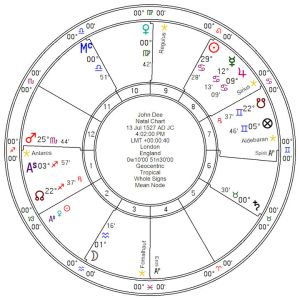
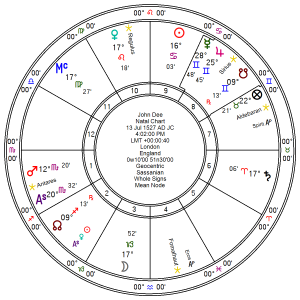 The Sun remains in Cancer but is now in the ninth house, as would be expected of someone who travelled widely in the pursuit of philosophical knowledge. Notably, Dee was perhaps the foremost expert on marine navigation of his time. and is justly credited with being influential in England’s developing naval prominence, most famously regarding his alleged role in the defeat of the Spanish Armada, but in a larger sense the firm idea of an Empire based on naval dominance.
The Sun remains in Cancer but is now in the ninth house, as would be expected of someone who travelled widely in the pursuit of philosophical knowledge. Notably, Dee was perhaps the foremost expert on marine navigation of his time. and is justly credited with being influential in England’s developing naval prominence, most famously regarding his alleged role in the defeat of the Spanish Armada, but in a larger sense the firm idea of an Empire based on naval dominance.